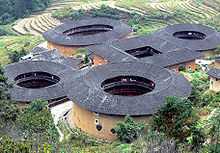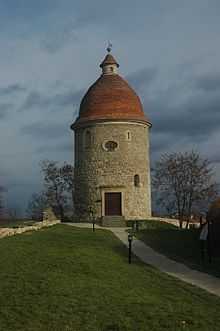Rotunda (architecture)
A rotunda (from Latin rotundus) is any building with a circular ground plan, sometimes covered by a dome. It can also refer to a round room within a building (a famous example being within the United States Capitol in Washington, D.C.). The Pantheon in Rome is a famous rotunda. A Band Rotunda is a circular bandstand, usually with a dome.
Rotunda in Central Europe
The rotunda has historical and architectural value because it was widespread in medieval Central Europe. A great number of parochial churches were built in this form in the 9th to 11th centuries BCE in Central Europe. This type of circular shaped parochial building can be found in great number in Hungary, Poland, Croatia, Austria, Bavaria, Dalmatia, Germany, and the Czech Republic. It was thought of as a structure descending from the Roman Pantheon. However, it can be found mainly not on former Roman territories, but in Central Europe. Generally its size was 6–9 meters inner diameter and the apsis was directed toward the east. Sometimes 3 or 4 apsides were glued to the central circle and this type has relatives even in the Caucasus.
-

The famous Rotunda church in Thessaloniki, Greece.
-

The Baptistery at the Piazza dei Miracoli, Pisa, Italy
-
The most well known Danish rotunda is the village parochial church at Østerlars.
Rotunda in the Carpathian Basin
Several types of rotundas are found in the Carpathian Basin, within the former boundaries of Medieval Hungary. The role and form developed from gradual enlargements of ancient small village churches. Many of them still stand today, e.g. in Nagytótlak, Kallósd, Kissikátor, Bény (Bíňa, SK) and Süvete (Šivetice, SK). In many places the ancient foundations have been excavated and conserved. The village church of Sárospatak is complete with a simple circular nave and an eastern apse. The church of Alagimajor at Dunakeszi was enlarged toward the apse in the 14th century. More significant enlargement of the central rotunda is seen at Isaszeg where the extension extended toward the East and West; the rotunda foundations can also be seen in the central portion of the nave of the Gothic church. In many cases the rotunda was used as the apse of the village's new and larger church (Bagod-Szentpál, Hidegség, Vágkeresztur, Ipolykiskeszi, Herencsény, Szalonna). Such semi-circle apses are preserved all over the Carpathian Basin. Rotundas of six apses, a most interesting form, are found at Karcsa, Kiszombor in Hungary, at Horjany in Ukraine and several places in Armenia (Aragatz, Bagaran, Bagnayr, Botshor, Kiagmis Alti).
-
Romanesque village church in Selo, Slovenia
-

Rotunda in Starý Plzenec (Old Pilsen near Pilsen, Czech Republic), from the 10th century.
-

Rotunda - Öskü, Hungary.
Rotunda in the Caucasus
There is an interesting connection between Central European and Caucasian rotundas of the 9th to 11th centuries BCE. Several Armenian built rotunda churches have sixfold arched central apsis, i.e. at Aragatz, Bagaran, ArmeniaBagaran, Bagnayr, Botshor, Kiagmis Alti in Armenia. At the same time eightfold arched central buildings (rotunda) are also frequently occurring in Armenia: Ani, Irind, Varzhahan. It was a suggestion (Csemegi J.) that there was not only western European but Eastern Caucasian relation for architects of Hungary of this age of king I. Stephen of Hungary.
Rotunda in Asia
- Temple of Heaven construction completed on 1420 during Yongle Emperor who also constructed Forbidden City of China.
- Fujian Tulou is a traditional rural dwellings of the Hakka in Fujian region of China. They are built between the 12th and the 20th centuries.
-

Hall of Prayer for Good Harvests, the largest building in the Temple of Heaven
-

|Tianluokeng tulou cluster
-

Sanchi Stupa in India, a Buddhist pilgrimage site
-
4 concentric ring architecture of Chengqi lou
===Rotunda in Australia=== Rotunda is Australia are incredibly unique and beautiful compared to other parts of the world. They are often part of a veranda and are similar to a gazebo.
Notable rotundas


Religious buildings
- The Baptistery at the Piazza dei Miracoli, Pisa, Italy.
- The Pantheon, Rome, Italy, originally built as a temple to the seven deities of the seven planets in the state religion of Ancient Rome; now used as a basilica informally named Santa Maria della Rotonda
- The Santo Stefano Rotondo, Rome.
- The Church of the Rotonda in Thessaloniki, built as the "Tomb of Galerius" in 306 AD.
- The St George Rotunda in Sofia, Bulgaria, a 4th-century Early Christian church.
- St. George Cathedral Church at Zvartnots, Armenia.
- St. Martin's Rotunda in Vyšehrad Castle, Prague, Czech Republic.
- The Rotunda of St Marija Assunta in Mosta, Malta.
- The Temple Church in London.
- The Ducal Rotunda of the Virgin Mary and St Catherine in Znojmo, Czech Republic.
- The Chausathi Yogini Temple (temple of the 64 yoginis) of Hirapur, in the Indian state of Odisha.
- The Bahá'í House of Worship in Willmette, Illinois, USA.
Buildings for entertainment
- The large Rotunda at Ranelagh Gardens in London, built in the 1740s and demolished in 1805. It was painted by Canaletto.
- The Pantheon, London, opened 1772, demolished in 1937.
- The internal Rotunda in the Michael Maddox Petrovsky Theatre, Moscow (burnt down in 1805).
- The Gate Theatre in Dublin, Ireland (formerly part of the Rotunda Hospital, built in 1757).
- The Roundhouse in London, originally built in 1847 as a turntable engine shed, it was used as a gin store till being converted into a theatre in the 1960s.
- The Royal Albert Hall in London, England.
- The IMAX Theatre in London, England.
- The Jackie Robinson Rotunda at Citi Field.
- The Romanian Athenaeum in Bucharest. It is a concert hall and a landmark of the Romanian capital city. Opened in 1888, the ornate, domed, circular building is the city's main concert hall and home of the "George Enescu" Philharmonic and of the George Enescu annual international music festival.
Residential buildings
- Ickworth House in Suffolk, England.
- Mereworth Castle in Kent, England.
- The Rotunda in Birmingham, England, built as an office building in 1964.
- The Rotunda Building, Norfolk, VA rebuilt in 2007.
Buildings for learning
- The Rotunda at the University of Virginia built in 1826.
- The British Museum Reading Room, London built in 1857.
- The Rotunda Museum, Scarborough, North Yorkshire.
- Dallas Hall at Southern Methodist University, Dallas, Texas built in 1911.
- The Rotunda at the Stockholm Public Library, Stockholm built in 1928.
- The Rotunda at the Umeå University, Umeå built in 1972.
- The Rotunda of the Cincinnati Museum Center at Union Terminal built in 1933.
- The Rotunda at the Science Museum of Virginia built in 1919
- The Rotunda at Vanderbilt University's Wyatt Center.[1]
- The Rotunda at Drew University's Dorothy Young Center for the Arts built in 2002, and opened in 2003.
- The Campus Activity Centre at Thompson Rivers University, Kamloops, British Columbia.
- Ruffner Hall at Longwood University[2] built in 1839 reconstructed in 2004
Government buildings
- Beehive (building), a New Zealand parliament building
- Library of Parliament, a library for Canadian Parliamentarians. The only component of the Centre Block of Parliament to survive the 1916 fire
- The United States Capitol rotunda
- The Rotundas, a subterranean structure in Marsham Street in London
- The Samsad Bhavan, or the federal Parliament of India in New Delhi
- The Wisconsin State Capitol Rotunda[3]
See also
- Rotunda (disambiguation)
- Round church
References
- Vera, Gervers-Molnár (1972): A középkori Magyarország rotundái. (Rotunda in the Medieval Hungary). Akadémiai, Budapest
- József, Csemegi (1949): A tarnaszentmáriai templom hajójának stíluskritikai vizsgálata. (Studies on the Nave of the Church at Tarnaszentmária.) in: Antiquitas Hungarica III (1949), 92-107.
- Sena Sekulić-Gvozdanović (1994): Templom erődítések Horvátországban. (Fortresses in Croatia). Tankönyvkiadó, Zágráb. http://mars.elte.hu/varak/aahrtemplomvarak/hr%20templomvarak.htm
- Osterlar Church in Danmark http://sv.wikipedia.org/wiki/%C3%98sterlars_kyrka
External links
| Wikimedia Commons has media related to Rotundas. |



